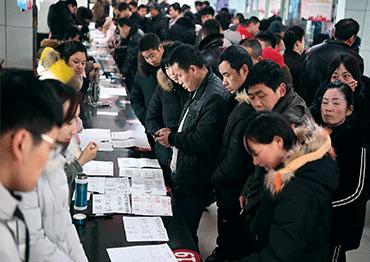By June, Xu was back in Beijing, and found it much harder than before to find stable work. Construction sites had not fully restarted, and odd jobs were hard to come by. When Xu finally found work, his employer complained there were faults in his craftsmanship and refused to pay.
“Opportunities have clearly dried up. Salaries are lower, too. But what worries us most is the instability. You don’t know when the next job will come,” Xu said.
Struggling to afford to live in Beijing without a stable job, Xu stayed in his hometown to save on expenses.
The pandemic brought a halt to much of the country’s economy in February, which has dragged employment down, despite the slow recovery. In July, the urban unemployment rate was 5.7 percent, 0.4 percent higher than the same period last year.
But millions of migrant workers from rural areas, who were more economically vulnerable under the pandemic, are not covered in the data, which means the unemployment rate is likely much higher. In the worst case scenario, about 25 million migrant workers could lose their jobs due to the pandemic, Chen Zhigang, a professor of rural economy at the School of Public Affairs at Zhejiang University, said in an online forum held by his school in June.
Sectors that rely on migrant workers such as construction, catering and hospitality were slow to resume. Catering, hospitality and wholesale and retail in the tertiary industry, which employed 51 percent of migrant workers in 2019, suffered under quarantine requirements and because of lower demand. In the second quarter, the added value of catering and hospitality still saw a year-on-year drop of 26.8 percent, while wholesale and retail fell 8.1 percent. Though the numbers looked better than the first quarter, the impact caused a wave of closures in the catering industry.
The blow to manufacturing, particularly exports, was magnified as the pandemic spread globally. China’s foreign trade volume plunged by 6.4 percent in the first quarter, with exports dropping by 11.4 percent. It climbed back in the second quarter but remained below normal levels. Many enterprises went bankrupt or suspended trading for lack of orders, resulting in large-scale unemployment.
Wen Simei, a professor and former president of South China Agricultural University, told NewsChina that by the end of June, nearly 90 percent of migrant workers had returned to their jobs in the Pearl River Delta Area, a manufacturing and trade hub in South China’s Guangdong Province. “But at least 40 percent of private companies have failed to fully resume production. Less than 70 percent managed to regain full employment. It means 30 percent of migrant workers might become jobless,” Wen said.
The pandemic will have a longer impact on employment than the 2008 financial crisis, Wen said, as the continued spread of the virus affects the international supply chain which consequently hurts the domestic supply chain.
Pan Chengfen, a deliveryman from South China’s Guangxi Zhuang Autonomous Region who helps operate a non-profit center for migrant workers in Dongguan, Guangdong Province, said that many have left Dongguan after losing their factory jobs or after employers cut their hours to reduce labor costs. Many were laid off after factories went bankrupt.
“The cost of living here is increasing. If you don’t earn enough, you can’t afford to be idle,” Pan said, adding that those who stay have to work multiple jobs to make ends meet. Pan has to take on more hours as more people turn to the delivery business for work, which dilutes the number of orders for each courier.
A survey by the South China Agricultural University in Guangzhou provided by Wen shows that in the Pearl River Delta Area, 15 percent of migrant workers returned to their hometowns after going back to work in cities following the pandemic lockdowns. Another 12 percent expressed a desire to return home, the majority of whom were born before 1980. “Unstable employment and decreased incomes are the main reasons for this,” Wen said.

 Old Version
Old Version

